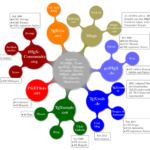Description: Word Webs are a collaborative approach to concept mapping. A central idea is added to a shared writing space. In small groups, students then generate a list of related ideas and organize them around the central idea in which they can visually represent how the ideas connect. This technique helps students to analyze challenging […]
Dialogue Journals
Description: In this activity, students keep a journal to capture their thinking about course readings, assignments, lectures, and class activities. They then exchange their journal with a peer to create an ongoing dialogue of questions, answers, insights and ideas. The students can develop their journal in a digital or analog format. The instructor can prompt […]
Note-Taking Pairs
Description: In this activity student partners work together to improve their note-taking skills. Over time, each student improves her individual note-taking skills. By working in pairs, students can compare notes on a class lecture, reading or other activity. They help each other to fill in the gaps in their notes, correct inaccuracies, and add detail […]
Learning Teams
Description: For this type of group, students are divided into groups at the beginning of the term. When you want to incorporate small group discussion or teamwork into your class, you direct the students to get into these term-long learning groups. Groups of four work well, because each foursome can be subdivided into pairs, depending […]
Think Pair-Share
Description: This strategy has three steps. First, students think individually about a particular question or scenario. Then they pair up to discuss and compare their ideas. Finally, they are given the chance to share their ideas in a large class discussion. Class size: any Time frame: 5-10 minutes Setting: No limitations Modality: Face-to-face, hybrid Comments: […]
Buzz Groups
Description: These groups involve students engaging in short, informal discussions, often in response to a particular sentence starter or question. At a transitional moment in the class, have students turn to 1-3 neighbors to discuss any difficulties in understanding, answer a prepared question, define or give examples of key concepts, or speculate on what will […]





